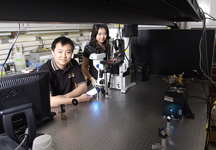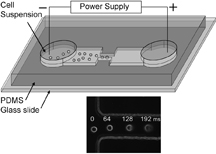Expanding cell girth indicates seriousness of breast cancer
How fat cells become after being exposed to a specialized electrical field is helping researchers determine whether cells are normal, cancerous or a stage of cancer already invading other parts of the body.
Purdue University scientists tested the electrical process and found cells that expanded the most were metastatic cancer, the term used when the disease has spread beyond its point of origin. The technique allows screening of single cells 300 times faster - five cells per second compared with the one cell per minute of previous methods, said Chang Lu, senior and corresponding author of the study currently online in the journal Analytic Chemistry. This rapid cell inspection permits testing of enough cells for diagnosis and determination of the disease’s level, he said.
“If you look at the properties of only a few cells, it would be a stretch to say they exactly represent a tissue cell population since tissues have tens of thousands of cells,” Lu said. “Our goal is to have a tool so that we can reputably look at large numbers of cells and obtain information about their biomechanical properties.”
Using breast cancer cells, Lu and his research team investigated cancer cells at different stages and compared their size to normal cells after all three types of cells were treated with the electrical process.
The research technique uses an electrical field within a microscopic fluid-filled channel through which a cell moves. As the cell is exposed to the electricity, it swells.
The cell expansion results because as cancer develops, it compromises the cell’s structure, or cytoskeleton. A metastatic cancer cell cytoskeleton is more prone to deformity than a primary cancer cell or a normal cell, said Lu, an assistant professor of agricultural and biological engineering. When cells were put through the electrical field that Lu and his colleagues used, pores opened in the cell membrane, allowing fluid from the microchannel into the cell itself.
Just like a person gaining a lot of weight, the cells balloon in size, with the biggest deformity appearing in the metastatic cells.
“Our approach - microfluidic electroporative flow cytometry - can exactly characterize the degree to which a cell can become deformed,” Lu said.
 A patent is pending on the technique.
A patent is pending on the technique.
The amount of electricity and the length of time the cell is exposed to it also determined how much the various types of cells expanded. Under the parameters that Lu’s team used, the metastatic cells expanded by 75 percent after electroporation, while primary cancer cells and normal cells expanded by 50 percent and 25 percent, respectively.
The Purdue scientists used a camera to measure how many cells were being screened over a predetermined time period. The camera must be able to capture changes in each cell one frame at a time.
The scientists want to make the screening process even faster, so they need a camera that can shoot frames even more rapidly than the one Lu’s team used for this study. This would provide more accurate measurement of cell expansion. They also want to use the technique to diagnose other types of cancers and other diseases. Tests on a blood disease already are under way.
 The eventual goal is to apply microfluidic electroporative flow cytometry in patient trials, Lu said.
The eventual goal is to apply microfluidic electroporative flow cytometry in patient trials, Lu said.
“But things become more complicated if you’re dealing with patient tissues rather than cell lines,” he said. “Cell lines contain only one type of cell; patient tissues have different kinds of cells.”
The Wallace H. Coulter Foundation and the National Science Foundation funded this study.
Lu also has appointments in Purdue’s Weldon School of Biomedical Engineering, School of Chemical Engineering and the Laboratory for Renewable Resources Engineering. Department of Agricultural and Biological Engineering postdoctoral student Ning Bao and graduate student Yihong Zhan co-authored the paper.
Writer: Susan A. Steeves, (765) 496-7481, ssteeves@purdue.edu
Source: Chang Lu, (765) 494-1188, changlu@purdue.edu
Ag Communications: (765) 494-2722;
Beth Forbes, forbes@purdue.edu
PHOTO CAPTION:
Purdue’s Chang Lu, from left, in the lab with graduate student Hsiang-Yu Wang. Lu, a Purdue assistant professor of agricultural and biological engineering, has found that how fat cells become after passing through an electric field in a microscopic fluid-filled channel indicates whether a cell is normal, cancerous or already metastatic. His technique allows screening of single cells 300 times faster than previous methods. (Purdue Agricultural Communication photo/Tom Campbell)
IMAGE CAPTION:
This schematic shows a microfluidic electroporative flow cytometer. The inset image shows the continuous increase in the cell size as the cell flows in the electrical field. (Purdue University graphic)